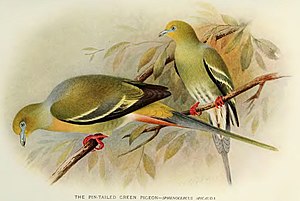Pointed-tailed green pigeon
| Pointed-tailed green pigeon | ||||||||||
|---|---|---|---|---|---|---|---|---|---|---|

Pointed-tailed green pigeon |
||||||||||
| Systematics | ||||||||||
|
||||||||||
| Scientific name | ||||||||||
| Treron apicauda | ||||||||||
| Blyth , 1846 |
The pointed- tailed green pigeon ( Treron apicauda ), also known as the green pigeon , is a species of pigeon birds. It is distributed in several subspecies in Southeast Asia.
The IUCN specifies the stock situation of the pointed-tailed green pigeon as harmless ( least concern ).
Appearance
The pointed-tailed green pigeon reaches a body length of 36 centimeters. It is a medium-sized, compactly built pigeon that is about the size of a small city pigeon . The tail accounts for between 14.4 and 19.2 centimeters. The beak is between 1.8 and 2.2 inches long. The gender dimorphism is low.
Appearance of the male
In the male, the wax skin of the beak is featherless. This makes the forehead appear steep. The front of the head to the nape of the neck is bright olive-green and turns into a bright olive-green at the nape of the coat. The small wing-coverts are also bright olive-green, the middle wing-coverts are matt olive-green with narrow lemon-yellow borders on the outer flags. The large wing-coverts are similar, but the edges are wider and the outer feathers are blackish. The wings are black with very narrow white borders. The wings of the hand are also black, but only the outermost feathers are lined with white. The back and the upper tail-coverts are bright yellow-olive, the tail is slate-gray. The middle pair of control springs is the longest and protrudes over the other springs by up to 8 millimeters.
The chin, throat and ear covers are bright yellowish green, the front neck is slightly darker. The chest is orange, the belly greenish yellow, the thighs and rump dark green, the individual feathers have white outer flags.
The iris is pink to brick red with an azure blue inner ring. The featherless eye ring is blue. The wax skin and beak are bright blue. The tip of the beak is blue-green.
Appearance of the females
The females are similar to the males, but the rear neck and coat are more bright olive-colored without any shade of gray. The throat, chin and chest are darker green. There is an orange tone missing on the chest. The under tail coverts are isabel colored. The middle pair of control feathers tends to be shorter than that of the males.
Young birds have a shorter tail with a middle pair of control feathers, which barely protrudes beyond the other feathers and which do not yet come to a point. The hems of the wings are still pale gray-green.
Possible confusion
In the range of the pointed-tailed green pigeon there are several other species of green pigeon with which it can be confused.
The white-bellied green pigeon is much smaller, and their body plumage is generally a bit darker. The under tail coverts are bright yellow, there is a noticeable white spot on the belly. The orbital ring is very wide. The wedge-tailed pigeon is smaller and always has an olive-colored belly. The middle pair of control springs is not pointed.
Distribution area and habitat
The range of the pointed-tailed green pigeon is Nepal, Bhutan, northern India, Bangladesh, the south of Sichuan and Yunnan, Myanmar and the northwest and north of Thailand, Laos and Vietnam. The pointed-tailed green pigeon is always a rare species within this large distribution area.
The pointed-tailed green pigeon is a forest-dwelling species that occurs in evergreen mountain forests. Outside of the breeding season, it can also be found in forest areas of the lowlands. The height distribution ranges from 600 to 1800 meters. In Nepal it has already been observed at an altitude of 2800 meters. She undertakes high-altitude hikes when food is scarce at high altitudes.
Way of life
The pointed-tailed green pigeon is a gregarious species that is usually found in groups of between 10 and 30 individuals. It lives almost exclusively in the treetops, where it climbs the branches with parrot-like dexterity. She only comes on the floor to drink and to take up grit . It eats a wide variety of fruits and berries. Figs play a particularly important role in their diet.
Subspecies
So far, three subspecies are known:
- Treron apicauda apicauda Blyth , 1846 occurs in the Himalayas over southwest China and Myanmar .
- Treron apicauda laotianus ( Delacour , 1926) is common in southern China, northern Vietnam and northern Laos .
- Treron apicauda lowei ( Delacour & Jabouille , 1924) occurs in Thailand and central Laos.
literature
- David Gibbs, Eustace Barnes and John Cox: Pigeons and Doves - A Guide to the Pigeons and Doves of the World . Pica Press, Sussex 2001, ISBN 90-74345-26-3 .
- Gerhard Rösler: The wild pigeons of the earth - free living, keeping and breeding . M. & H. Schaper Verlag, Alfeld-Hannover 1996, ISBN 3-7944-0184-0 .
Web links
- Treron apicauda in the endangered Red List species the IUCN 2012. Posted by: BirdLife International, 2012. Accessed November 13, 2016th
- BirdLife International: Species Factsheet - Pin-tailed Green-pigeon ( Treron apicauda ) . Retrieved February 21, 2018.
- Videos, photos and sound recordings of pin-tailed green pigeon (Treron apicauda) in the Internet Bird Collection
- Pointed-tailed green pigeon ( Treron apicauda ) at Avibase; accessed on February 21, 2018.
- Treron apicauda in the Integrated Taxonomic Information System (ITIS)
- xeno-canto: Sound recordings - Pin-tailed Green-pigeon ( Treron apicauda )
- Pin-tailed green-pigeon (Treron apicauda) in the Encyclopedia of Life . Retrieved February 21, 2018.
